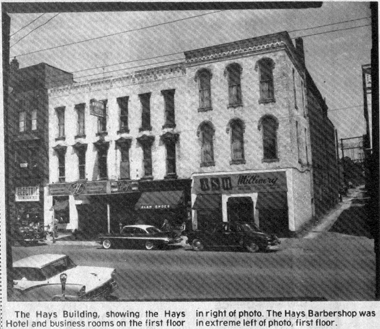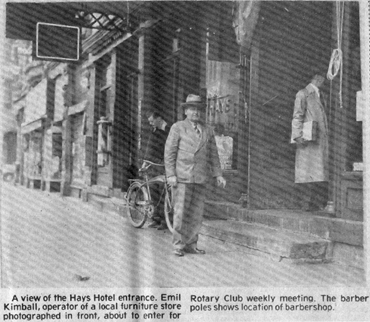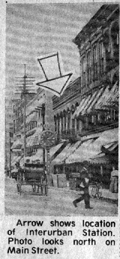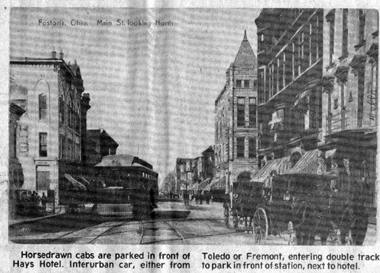July 2, 1981




Picture #1 – The Hays Building, showing the Hays Hotel and business rooms on the first floor in right of photo. The Hays Barbershop was in extreme left of photo, first floor.
Picture #2 – A view of the Hays Hotel entrance. Emil Kimball, operator of a local furniture store photographed in front, about to enter for Rotary Club weekly meeting. The barber poles shows location of barbershop.
Picture #3 – Arrow shows location of Interurban Station. Photo looks north on Main Street.
Picture #4 – Horsedrawn cabs are parked in front of Hays Hotel. Interurban car, either from Toledo or Fremont, entering double track to park in front of station, next to hotel.
Although there were many hotels in Fostoria in the late 1880s and early 1900s, the Hays House, which was introduced in last week’s column was probably the most famous, in addition to being the oldest.
Its location in the business district added to its prestige, as did its close proximity to the Interurban Station, where the electric trolley cars from Tiffin, Findlay, Toledo and Fremont, with connections for Cleveland, Detroit, Columbus, Lima and other cities, brought traveling men to town to transact business.
The Hays House had a bar, which was an important facility for traveling men and a seven-chair barbershop to serve travelers and the local trade.
The hotel dining room was excellent, always headed by a fine chef. The chef who was there in the early 1920s was good and though I do not recall his name, I can’t forget his pies, since he often gave me a piece of my choice when I delivered the printed menus to him.
FREE PIE
I was learning the printers trade at the Review. The hotel’s back door was adjacent to a rear window in the Review. When I had completed printing the menus for that day, done on a small hand-operated press, I delivered them and got my pie…usually cream.
At one time, all Fostoria’s service clubs used the Hays dining room facilities for their weekly dinner meetings.
In the summer there was always a row of chairs in front of the hotel, occupied by guests, or residents who took advantage of them to discuss affairs and watch traffic.
About the Hays Barbershop…I do not know who the first proprietor was, but do know that Fred Gerlinger was the owner during the early part of the 1900s. (See Potluck article March 30, 1977 about barbershops).
When Gerlinger quit barbering to follow other business pursuits, the Hays Barbershop was taken over by John Heldt. It is not unusual for males to do needlework today, but back then it wasn’t, however, when Heldt wasn’t cutting hair or shaving a customer he was crocheting.
Later, Heldt sold out to three barbers who worked for him…Mural Eckert, Joe McChaney and Frank Babcock. After the death of the other two, Eckert continued to operate the Hays shop until about 1942, when he moved to the Smoke House.
When Mural Eckert moved his barbershop from the Hays Building, that room be- came a bar, operated first by Cecil Burkhardt and later by James Tsantles.
HAYS HAD FIVE OWNERS
The Hays Building and the hotel business which was originally owned by members of the Hays family, and lastly by David Hays, was finally sold to A.P. Hamil in 1899. David Hays lived at 220 W. Tiffin St.
A 1915 record showed ownership of the property as Myrtle E. List and Elizabeth A. Bevard, both widows at that time. Presumably, their husbands had previous ownership, but that I can not verify. According to Jim Guernsey, the McDonel family finally purchased and in about 1926 or 1927 it was leased to C.W. Casselman, who was assisted by Charles E. Lyon in managing it.
Not too long before the disastrous fire, which destroyed the Alcott Block and Hays Building (presented in last week’s article) the property had been sold to Pete Tsantles.
OTHER FIRMS THERE
There were two other business rooms in the Hays Building, as can be seen in Photo No. 1, which at that time, about 1955 or 1956, were occupied by Alan Shoes Alan Burger) and Ash Millinery.
In earlier years, about 1930, Bill’s Economy Store, started by William Grobman, was located in the room where Ash Millinery was later. When Grobman’s business grew, and he needed more space, he moved to the location where Bill’s Men’s and Boys Wear is now. Grobman was a popular businessman and active in civic affairs.
From 1936 to 1957, Idelia Dreitzler was proprietor of The Dress Shop where Bill’s Economy Store had previously been.
Also located in the Hays Building at one time was The Fostoria Auto Club and the Hays Taxi Co…that was when autos replaced the horsedrawn vehicles. Hays Taxi was owned by H. Cline, W. Weber and E. Hieber. Mary Pence ran the Auto Club.
Now, we jump across the alley to the Interurban Station, next to the Hays Building. The station was in the building shown in Photo No. 3. In all of searches, I have never found an old photo of the station which showed it properly, with a trolley car in front. See Photo No. 4.
About the station…like most interurban passenger stations of that era, it provided adequate seating, shoeshine and hatcleaning facilities, barbershop, food and confections, newspaper sales and restrooms.
REMEMBER SAM?
Many readers will remember “Sam” the blind man who was always stationed in front of the station, selling newspapers for a livelihood. Your author also sold newspapers on Main Street, prior to the time I started with the Fostoria Daily Review in the old Foster home. The interurban cars always carried traveling men who purchased newspapers, as did the downtown businessmen, many of whom became my regular customers. The complete story about the three electric interurbans which served Fostoria was carried in Potluck articles appearing May 4, 11, and 18, 1977).
On the second floor of the interurban building there was located the offices for the Toledo, Fostoria, and Findlay (TF..F), E. Smith being the general manager.
Others on the second floor were J.R. Bradner, realtor, who also dealt in sure- ty bonds and fire insurance. He was once Mayor of Fostoria and father of Fos- torian Harry Bradner. Also on the second floor of the building was Kimes- Omlor Co., general contractors, consisting of H.E. Kimes, A.J. Omlor, R.O. Laurence, E.J. Hess. Kimes was the father of Fostorian Elwood Kimes, and Omlor was the father of Fostorian R. “Zeke” Omlor. (Continued next week)